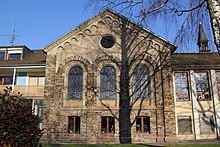Luther Chapel (Koblenz)

The Luther Chapel is a Protestant chapel in Koblenz . The chapel in the Horchheim district was originally built as a garden and tea house for the Mendelssohn family from Berlin . In the course of time, the building has undergone some renovations and additions.
history
In the Middle Ages, the Altenberger Hof, which belonged to the Altenberg Abbey , stood in the area of today's Luther Chapel . Joseph Mendelssohn acquired a neighboring palace in 1818 , which belonged to the Trier Hofrat Johann Jacob Fritsch, and had it expanded by the architect Johann Claudius von Lassaulx . The former Altenberger Hof - the area reached as far as the Rhine and is now cut through by the right-hand Rhine route of the railway - was also bought by Mendelssohn in 1825 along with thousands of vines. Here he had Lassaulx build a garden and tea house in the middle of the spacious park around 1830 .
His nephew, the composer Felix Mendelssohn Bartholdy , stayed at the palace in Horchheim several times on his travels. Here Mendelssohn Bartholdy completed his 2nd piano concerto in 1837 . Other famous personalities, such as Alexander von Humboldt , Georg Friedrich Hegel , Ludwig Uhland as well as Melchior and Sulpiz Boisserée , were guests in the palace. The palace burned down in 1970 and was demolished three years later.
In 1902, Mendelssohn's heirs donated the property to Empress Auguste Viktoria , who passed it on to the Kaiserswerther Diakonissenanstalt a year later . The deaconesses used it as a rest home until it was sold to the Evangelical Parish of Pfaffendorf in 1922 . The railway engineer Schlegel rebuilt the former garden and tea house and on June 11, 1922 the building was consecrated as the Luther Chapel.
In the Second World War damaged the chapel in 1948 and again prepared according to plans by Möllering from Dusseldorf redesigned. After that, the Protestant community grew strongly and the chapel was doubled in 1956 by the Koblenz architect Friedhelm Worm to the south with an extension. In 1962 a retirement home was added. The facade was renovated in 2007. Today only the Rhine side of the former Lassaulx'schen garden and tea house can be seen, the other three sides are covered by the extensions.
construction
The former garden and tea house was originally a free-standing, almost square two-storey building with a gable roof . The facade on the Rhine side is multilayered and structured through the use of different colored materials. The pilasters at the two corners carry a verge cornice made of light basalt tuff with a round arch frieze .
A floating staircase led to the garden room from the north. The slate quarry has a large, two-bay , three-aisled hall . It is spanned over two central columns by a ribbed vault, in which six baroque keystones with scrollwork cartouches of various house brands are set, which presumably come from the Altenberger Hof. On the Rhine side, the hall has high, arched windows. Above in the gable field a large round opening with a profiled frame. The extension from 1956 has a roof ridge offset by 90 degrees , which is crowned with a small roof turret.
Parish
The Luther Chapel is located in the valley district of the "Evangelical Church Community Koblenz-Pfaffendorf", which also includes the Reconciliation Church in Arenberg , the Evangelical Church in Pfaffendorf and the Hope Church on Pfaffendorfer Höhe .
Monument protection
The Luther Chapel is a protected cultural monument under the Monument Protection Act (DSchG) and entered in the list of monuments of the state of Rhineland-Palatinate . It is located in Koblenz-Horchheim at Reiffenbergstrasse 8/10 .
The Luther Chapel has been part of the Upper Middle Rhine Valley UNESCO World Heritage Site since 2002 .
See also
literature
- Energieversorgung Mittelrhein GmbH (ed.): History of the city of Koblenz. Overall editing: Ingrid Bátori in conjunction with Dieter Kerber and Hans Josef Schmidt. Theiss, Stuttgart 1992-1993;
- Volume 1: From the beginning to the end of the electoral era. 1992, ISBN 3-8062-0876-X ;
- Volume 2: From the French city to the present. 1993, ISBN 3-8062-1036-5 .
- Fritz Michel : The art monuments of the city of Koblenz. The profane monuments and the suburbs , Munich Berlin 1954, (Die Kunstdenkmäler von Rheinland-Pfalz, first volume).
- Festschrift for the anniversary 200 years of Protestantism in Koblenz - Pragmatic, Prussian, Protestant , series of publications by the Association for Rhenish Church History - Volume 161, 2003
- Ulrike Weber (edit.): City of Koblenz. City districts (= monument topography Federal Republic of Germany . Cultural monuments in Rhineland-Palatinate. Vol. 3, 3). Werner, Worms 2013, ISBN 978-3-88462-345-9 .
Web links
Individual evidence
- ↑ Evangelical Church Community Koblenz-Pfaffendorf in: Evangelical Church District Koblenz
- ↑ General Directorate for Cultural Heritage Rhineland-Palatinate (ed.): Informational directory of cultural monuments - district-free city of Koblenz (PDF; 1.5 MB), Koblenz 2013
Coordinates: 50 ° 19 ′ 48 ″ N , 7 ° 35 ′ 45 ″ E
